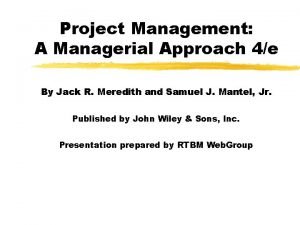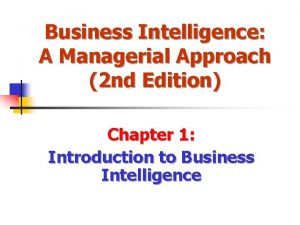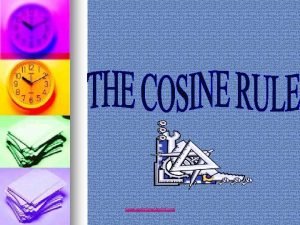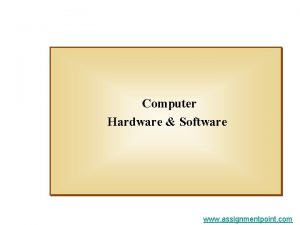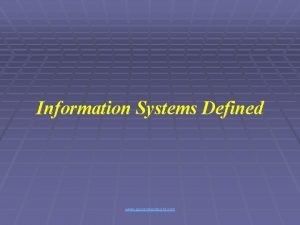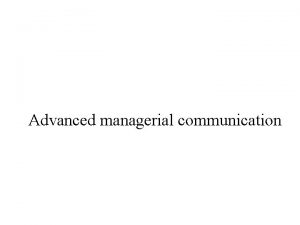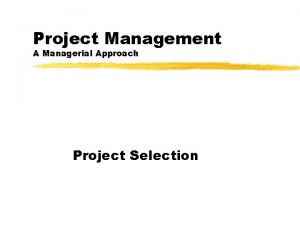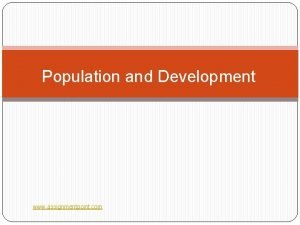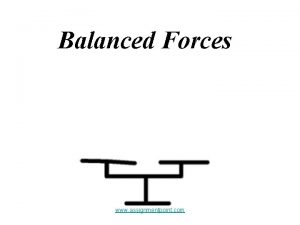Project Management for Managerial Approach www assignmentpoint com






















- Slides: 22

Project Management for Managerial Approach www. assignmentpoint. com

Project Selection z Project selection is the process of evaluating individual projects or groups of projects, and then choosing to implement some set of them so that the objectives of the parent organization will be achieved z Managers often use decision-aiding models to extract the relevant issues of a problem from the details in which the problem is embedded z Models represent the problem’s structure and can be useful in selecting and evaluating projects

Criteria for Project Selection Models z Realism - reality of manager’s decision z Capability- able to simulate different scenarios and optimize the decision z Flexibility - provide valid results within the range of conditions z Ease of Use - reasonably convenient, easy execution, and easily understood z Cost - Data gathering and modeling costs should be low relative to the cost of the project z Easy Computerization - must be easy and convenient to gather, store and manipulate data in the model

Nature of Project Selection Models y 2 Basic Types of Models x. Numeric x. Nonnumeric y. Two Critical Facts: x. Models do not make decisions - People do! x. All models, however sophisticated, are only partial representations of the reality the are meant to reflect

Nonnumeric Models z Sacred Cow - project is suggested by a senior and powerful official in the organization z Operating Necessity - the project is required to keep the system running z Competitive Necessity - project is necessary to sustain a competitive position z Product Line Extension - projects are judged on how they fit with current product line, fill a gap, strengthen a weak link, or extend the line in a new desirable way. z Comparative Benefit Model - several projects are considered and the one with the most benefit to the firm is selected

Numeric Models: Profit/Profitability y. Payback period - initial fixed investment/estimated annual cash inflows from the project y. Average Rate of Return - average annual profit/average investment y. Discounted Cash Flow - Present Value Method y. Internal Rate of Return - Finds rate of return that equates present value of inflows and outflows y. Profitability Index - NPV of all future expected cash flows/initial cash investment

Information Base for Selections z. Accounting Data z. Measurements y. Subjective vs. Objective y. Quantitative vs. Qualitative y. Reliable vs. Unreliable y. Valid vs. Invalid z. Technological Shock

Project Proposals z. Which projects should be bid on? z. How should the proposal-preparation process be organized and staffed? z. How much should be spent on preparing proposals for bids? z. How should the bid prices be set? z. What is the bidding strategy? Is it ethical?

Project Proposal Contents z Executive Summary z Cover Letter z Nature of the technical problem z Plan for Implementation of Project z Plan for Logistic Support & Administration of the project z Description of group proposing to do the work z Any relevant past experience that can be applied Chapter 2 -13

Summary z. Primary selection criteria are realism, capability, flexibility, ease of use, and cost z. In preparing to use a model, a firm must identify its objectives, weighting them relative to each other, and determining the probable impacts of the project on the firm’s competitive abilities. z. Models can be numeric or nonnumeric Chapter 2 -14

Summary z Numeric Models can be subdivided into profitability and scoring models z To handle uncertainty, pro forma documents, risk analysis, and simulation with sensitivity analysis are helpful z Special care should be given to data in project selection models. Of concern are data taken from accounting data base and the effect of technological shock

Summary z Project proposals generally consist of several sections: the technical approach, the implementation plan, the plan for logistics support and administration, and past experience. z The history of project selection models has shown an increase in the use of formal models, particularly profitability models.

Project Selection Figure 2 -1

Project Selection Figure 2 -2

Project Selection Table Files

Project Selection

Project Selection

Project Selection

Project Selection

Project Selection

Project Selection

Copyright © 2000 John Wiley & Sons, Inc. All rights reserved. Reproduction or translation of this work beyond that permitted in Section 117 of the 1976 United States Copyright Act without the express written permission of the copyright owner is unlawful. Request for further information should be addressed to the Permissions Department, John Wiley & Sons, Inc. The purchaser may make back-up copies for his/her own use only and not for distribution or resale. The Publisher assumes no responsibility for errors, omissions, or damages, caused by the use of these programs or from the use of the information contained herein.
 Project management a managerial approach
Project management a managerial approach Project management a managerial approach
Project management a managerial approach Dậy thổi cơm mua thịt cá
Dậy thổi cơm mua thịt cá Cơm
Cơm Group managerial approach in classroom management
Group managerial approach in classroom management Traditional vs modern project management
Traditional vs modern project management Sport law a managerial approach
Sport law a managerial approach Business intelligence a managerial approach
Business intelligence a managerial approach Approaches to study public administration
Approaches to study public administration Managerial approach in curriculum
Managerial approach in curriculum Assignmentpoint
Assignmentpoint Www.assignmentpoint.com
Www.assignmentpoint.com Assignmentpoint.com
Assignmentpoint.com Hindustan unilever mission and vision
Hindustan unilever mission and vision Income elasticity of demand
Income elasticity of demand Objectives of computer hardware
Objectives of computer hardware Assignmentpoint.com
Assignmentpoint.com Assignmentpoint
Assignmentpoint Www.assignmentpoint.com
Www.assignmentpoint.com Mail @ assignmentpoint.com
Mail @ assignmentpoint.com Mail @ assignmentpoint.com
Mail @ assignmentpoint.com Assignment point.com
Assignment point.com Assignmentpoint.com
Assignmentpoint.com

